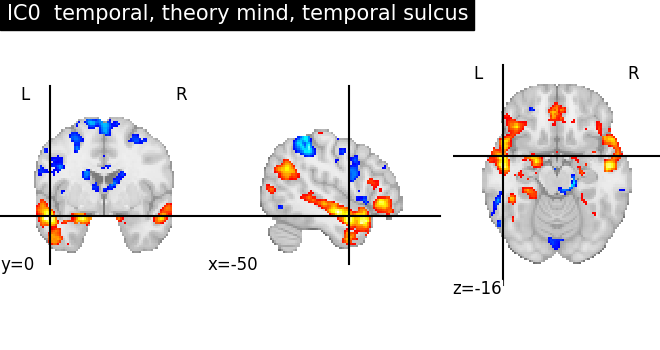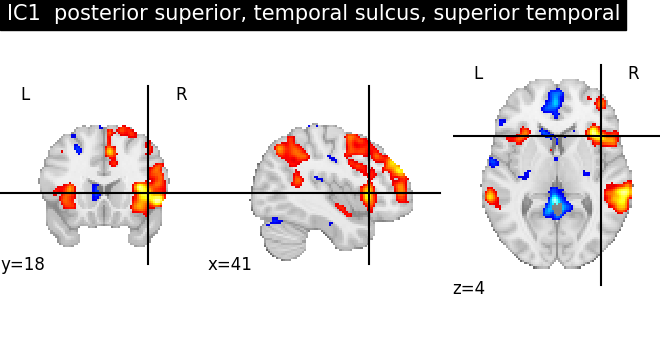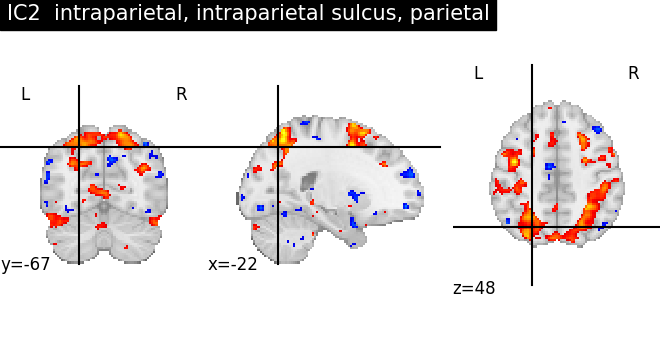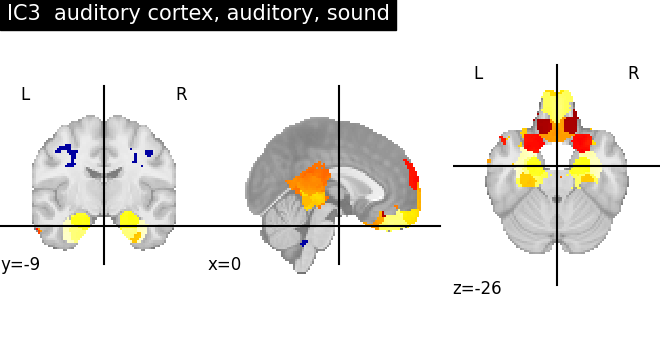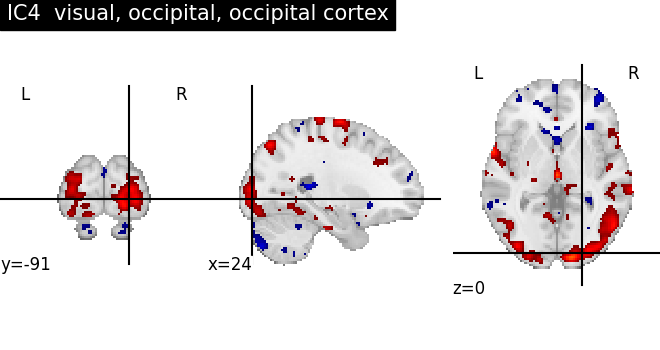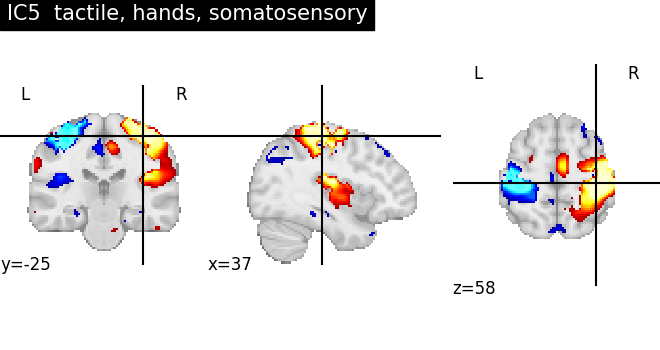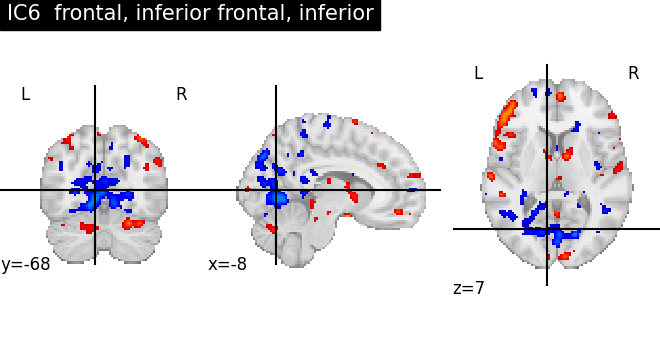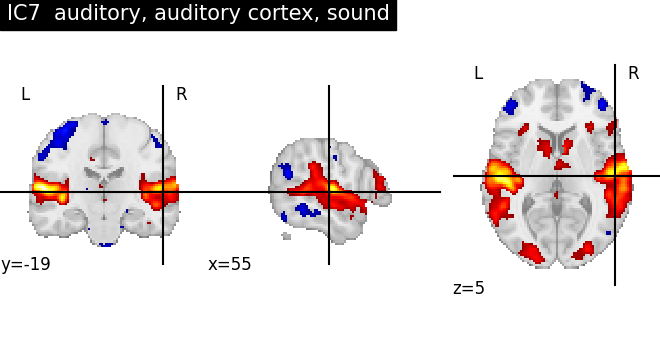Note
Go to the end to download the full example code. or to run this example in your browser via Binder
NeuroVault cross-study ICA maps¶
This example shows how to download statistical maps from NeuroVault, label them with NeuroSynth terms, and compute ICA components across all the maps.
See fetch_neurovault
documentation for more details.
Note
If you are using Nilearn with a version older than 0.9.0,
then you should either upgrade your version or import maskers
from the input_data module instead of the maskers module.
That is, you should manually replace in the following example all occurrences of:
from nilearn.maskers import NiftiMasker
with:
from nilearn.input_data import NiftiMasker
import numpy as np
from scipy import stats
from sklearn.decomposition import FastICA
from nilearn.datasets import fetch_neurovault, load_mni152_brain_mask
from nilearn.image import smooth_img
from nilearn.maskers import NiftiMasker
from nilearn.plotting import plot_stat_map, show
Get image and term data¶
# Download images
# Here by default we only download 80 images to save time,
# but for better results I recommend using at least 200.
print(
"Fetching Neurovault images; "
"if you haven't downloaded any Neurovault data before "
"this will take several minutes."
)
nv_data = fetch_neurovault(
max_images=30, fetch_neurosynth_words=True, timeout=30.0
)
images = nv_data["images"]
term_weights = nv_data["word_frequencies"]
vocabulary = nv_data["vocabulary"]
if term_weights is None:
term_weights = np.ones((len(images), 2))
vocabulary = np.asarray(["Neurosynth is down", "Please try again later"])
# Clean and report term scores
term_weights[term_weights < 0] = 0
total_scores = np.mean(term_weights, axis=0)
print("\nTop 10 neurosynth terms from downloaded images:\n")
for term_idx in np.argsort(total_scores)[-10:][::-1]:
print(vocabulary[term_idx])
Fetching Neurovault images; if you haven't downloaded any Neurovault data before this will take several minutes.
[fetch_neurovault] Dataset found in /home/runner/nilearn_data/neurovault
[fetch_neurovault] Reading local neurovault data.
[fetch_neurovault] Downloading file:
https://neurosynth.org/api/decode/?neurovault=32980
[fetch_neurovault] Download succeeded, downloaded to:
/home/runner/nilearn_data/neurovault/collection_1952/neurosynth_words_for_image_
32980.json
[fetch_neurovault] Already fetched 1 image
[fetch_neurovault] 1 image found on local disk.
[fetch_neurovault] Reading server neurovault data.
[fetch_neurovault] Scroll collections: getting new batch:
https://neurovault.org/api/collections/?limit=100&offset=0
[fetch_neurovault] Scroll collections: batch size: 100
[fetch_neurovault] Scroll images from collection 921: getting new batch:
https://neurovault.org/api/collections/921/images/?limit=100&offset=0
[fetch_neurovault] Scroll images from collection 921: batch size: 1
[fetch_neurovault] On neurovault.org: no image matched query in collection 921
[fetch_neurovault] Scroll images from collection 440: getting new batch:
https://neurovault.org/api/collections/440/images/?limit=100&offset=0
[fetch_neurovault] Scroll images from collection 440: batch size: 2
[fetch_neurovault] On neurovault.org: no image matched query in collection 440
[fetch_neurovault] Scroll images from collection 496: getting new batch:
https://neurovault.org/api/collections/496/images/?limit=100&offset=0
[fetch_neurovault] Scroll images from collection 496: batch size: 1
[fetch_neurovault] On neurovault.org: no image matched query in collection 496
[fetch_neurovault] Scroll images from collection 4008: getting new batch:
https://neurovault.org/api/collections/4008/images/?limit=100&offset=0
[fetch_neurovault] Scroll images from collection 4008: batch size: 1
[fetch_neurovault] Downloading file:
http://neurovault.org/media/images/4008/spmT_0001.nii.gz
[fetch_neurovault] Download succeeded, downloaded to:
/home/runner/nilearn_data/neurovault/collection_4008/image_65426.nii.gz
[fetch_neurovault] Downloading file:
https://neurosynth.org/api/decode/?neurovault=65426
[fetch_neurovault] Download succeeded, downloaded to:
/home/runner/nilearn_data/neurovault/collection_4008/neurosynth_words_for_image_
65426.json
[fetch_neurovault] Already fetched 2 images
[fetch_neurovault] On neurovault.org: 1 image matched query in collection 4008
[fetch_neurovault] Scroll images from collection 4: getting new batch:
https://neurovault.org/api/collections/4/images/?limit=100&offset=0
[fetch_neurovault] Scroll images from collection 4: batch size: 1
[fetch_neurovault] On neurovault.org: no image matched query in collection 4
[fetch_neurovault] Scroll images from collection 79: getting new batch:
https://neurovault.org/api/collections/79/images/?limit=100&offset=0
[fetch_neurovault] Scroll images from collection 79: batch size: 5
[fetch_neurovault] Downloading file:
http://neurovault.org/media/images/79/neurosynth_spectral_01.nii.gz
[fetch_neurovault] Download succeeded, downloaded to:
/home/runner/nilearn_data/neurovault/collection_79/image_11020.nii.gz
[fetch_neurovault] Downloading file:
https://neurosynth.org/api/decode/?neurovault=11020
[fetch_neurovault] Download succeeded, downloaded to:
/home/runner/nilearn_data/neurovault/collection_79/neurosynth_words_for_image_11
020.json
[fetch_neurovault] Already fetched 3 images
[fetch_neurovault] Downloading file:
http://neurovault.org/media/images/79/neurosynth_spectral_01_1.nii.gz
[fetch_neurovault] Download succeeded, downloaded to:
/home/runner/nilearn_data/neurovault/collection_79/image_11021.nii.gz
[fetch_neurovault] Downloading file:
https://neurosynth.org/api/decode/?neurovault=11021
[fetch_neurovault] Download succeeded, downloaded to:
/home/runner/nilearn_data/neurovault/collection_79/neurosynth_words_for_image_11
021.json
[fetch_neurovault] Already fetched 4 images
[fetch_neurovault] On neurovault.org: 2 images matched query in collection 79
[fetch_neurovault] Scroll images from collection 1257: getting new batch:
https://neurovault.org/api/collections/1257/images/?limit=100&offset=0
[fetch_neurovault] Scroll images from collection 1257: batch size: 100
[fetch_neurovault] Downloading file:
http://neurovault.org/media/images/1257/abstract_knowledge_regparam.nii.gz
[fetch_neurovault] Download succeeded, downloaded to:
/home/runner/nilearn_data/neurovault/collection_1257/image_17327.nii.gz
[fetch_neurovault] Downloading file:
https://neurosynth.org/api/decode/?neurovault=17327
[fetch_neurovault] Download succeeded, downloaded to:
/home/runner/nilearn_data/neurovault/collection_1257/neurosynth_words_for_image_
17327.json
[fetch_neurovault] Already fetched 5 images
[fetch_neurovault] Downloading file:
http://neurovault.org/media/images/1257/acoustic_processing_regparam.nii.gz
[fetch_neurovault] Download succeeded, downloaded to:
/home/runner/nilearn_data/neurovault/collection_1257/image_17328.nii.gz
[fetch_neurovault] Downloading file:
https://neurosynth.org/api/decode/?neurovault=17328
[fetch_neurovault] Download succeeded, downloaded to:
/home/runner/nilearn_data/neurovault/collection_1257/neurosynth_words_for_image_
17328.json
[fetch_neurovault] Already fetched 6 images
[fetch_neurovault] Downloading file:
http://neurovault.org/media/images/1257/action_perception_regparam.nii.gz
[fetch_neurovault] Download succeeded, downloaded to:
/home/runner/nilearn_data/neurovault/collection_1257/image_17329.nii.gz
[fetch_neurovault] Downloading file:
https://neurosynth.org/api/decode/?neurovault=17329
[fetch_neurovault] Download succeeded, downloaded to:
/home/runner/nilearn_data/neurovault/collection_1257/neurosynth_words_for_image_
17329.json
[fetch_neurovault] Already fetched 7 images
[fetch_neurovault] Downloading file:
http://neurovault.org/media/images/1257/action_regparam.nii.gz
[fetch_neurovault] Download succeeded, downloaded to:
/home/runner/nilearn_data/neurovault/collection_1257/image_17330.nii.gz
[fetch_neurovault] Downloading file:
https://neurosynth.org/api/decode/?neurovault=17330
[fetch_neurovault] Download succeeded, downloaded to:
/home/runner/nilearn_data/neurovault/collection_1257/neurosynth_words_for_image_
17330.json
[fetch_neurovault] Already fetched 8 images
[fetch_neurovault] Downloading file:
http://neurovault.org/media/images/1257/activation_level_regparam.nii.gz
[fetch_neurovault] Download succeeded, downloaded to:
/home/runner/nilearn_data/neurovault/collection_1257/image_17331.nii.gz
[fetch_neurovault] Downloading file:
https://neurosynth.org/api/decode/?neurovault=17331
[fetch_neurovault] Download succeeded, downloaded to:
/home/runner/nilearn_data/neurovault/collection_1257/neurosynth_words_for_image_
17331.json
[fetch_neurovault] Already fetched 9 images
[fetch_neurovault] Downloading file:
http://neurovault.org/media/images/1257/activation_regparam.nii.gz
[fetch_neurovault] Download succeeded, downloaded to:
/home/runner/nilearn_data/neurovault/collection_1257/image_17332.nii.gz
[fetch_neurovault] Downloading file:
https://neurosynth.org/api/decode/?neurovault=17332
[fetch_neurovault] Download succeeded, downloaded to:
/home/runner/nilearn_data/neurovault/collection_1257/neurosynth_words_for_image_
17332.json
[fetch_neurovault] Already fetched 10 images
[fetch_neurovault] Downloading file:
http://neurovault.org/media/images/1257/active_maintenance_regparam.nii.gz
[fetch_neurovault] Download succeeded, downloaded to:
/home/runner/nilearn_data/neurovault/collection_1257/image_17333.nii.gz
[fetch_neurovault] Downloading file:
https://neurosynth.org/api/decode/?neurovault=17333
[fetch_neurovault] Download succeeded, downloaded to:
/home/runner/nilearn_data/neurovault/collection_1257/neurosynth_words_for_image_
17333.json
[fetch_neurovault] Already fetched 11 images
[fetch_neurovault] Downloading file:
http://neurovault.org/media/images/1257/active_retrieval_regparam.nii.gz
[fetch_neurovault] Download succeeded, downloaded to:
/home/runner/nilearn_data/neurovault/collection_1257/image_17334.nii.gz
[fetch_neurovault] Downloading file:
https://neurosynth.org/api/decode/?neurovault=17334
[fetch_neurovault] Download succeeded, downloaded to:
/home/runner/nilearn_data/neurovault/collection_1257/neurosynth_words_for_image_
17334.json
[fetch_neurovault] Already fetched 12 images
[fetch_neurovault] Downloading file:
http://neurovault.org/media/images/1257/acuity_regparam.nii.gz
[fetch_neurovault] Download succeeded, downloaded to:
/home/runner/nilearn_data/neurovault/collection_1257/image_17335.nii.gz
[fetch_neurovault] Downloading file:
https://neurosynth.org/api/decode/?neurovault=17335
[fetch_neurovault] Download succeeded, downloaded to:
/home/runner/nilearn_data/neurovault/collection_1257/neurosynth_words_for_image_
17335.json
[fetch_neurovault] Already fetched 13 images
[fetch_neurovault] Downloading file:
http://neurovault.org/media/images/1257/adaptation_regparam.nii.gz
[fetch_neurovault] Download succeeded, downloaded to:
/home/runner/nilearn_data/neurovault/collection_1257/image_17336.nii.gz
[fetch_neurovault] Downloading file:
https://neurosynth.org/api/decode/?neurovault=17336
[fetch_neurovault] Download succeeded, downloaded to:
/home/runner/nilearn_data/neurovault/collection_1257/neurosynth_words_for_image_
17336.json
[fetch_neurovault] Already fetched 14 images
[fetch_neurovault] Downloading file:
http://neurovault.org/media/images/1257/adaptive_control_regparam.nii.gz
[fetch_neurovault] Download succeeded, downloaded to:
/home/runner/nilearn_data/neurovault/collection_1257/image_17337.nii.gz
[fetch_neurovault] Downloading file:
https://neurosynth.org/api/decode/?neurovault=17337
[fetch_neurovault] Download succeeded, downloaded to:
/home/runner/nilearn_data/neurovault/collection_1257/neurosynth_words_for_image_
17337.json
[fetch_neurovault] Already fetched 15 images
[fetch_neurovault] Downloading file:
http://neurovault.org/media/images/1257/addiction_regparam.nii.gz
[fetch_neurovault] Download succeeded, downloaded to:
/home/runner/nilearn_data/neurovault/collection_1257/image_17338.nii.gz
[fetch_neurovault] Downloading file:
https://neurosynth.org/api/decode/?neurovault=17338
[fetch_neurovault] Download succeeded, downloaded to:
/home/runner/nilearn_data/neurovault/collection_1257/neurosynth_words_for_image_
17338.json
[fetch_neurovault] Already fetched 16 images
[fetch_neurovault] Downloading file:
http://neurovault.org/media/images/1257/affect_perception_regparam.nii.gz
[fetch_neurovault] Download succeeded, downloaded to:
/home/runner/nilearn_data/neurovault/collection_1257/image_17339.nii.gz
[fetch_neurovault] Downloading file:
https://neurosynth.org/api/decode/?neurovault=17339
[fetch_neurovault] Download succeeded, downloaded to:
/home/runner/nilearn_data/neurovault/collection_1257/neurosynth_words_for_image_
17339.json
[fetch_neurovault] Already fetched 17 images
[fetch_neurovault] Downloading file:
http://neurovault.org/media/images/1257/affect_recognition_regparam.nii.gz
[fetch_neurovault] Download succeeded, downloaded to:
/home/runner/nilearn_data/neurovault/collection_1257/image_17340.nii.gz
[fetch_neurovault] Downloading file:
https://neurosynth.org/api/decode/?neurovault=17340
[fetch_neurovault] Download succeeded, downloaded to:
/home/runner/nilearn_data/neurovault/collection_1257/neurosynth_words_for_image_
17340.json
[fetch_neurovault] Already fetched 18 images
[fetch_neurovault] Downloading file:
http://neurovault.org/media/images/1257/agency_regparam.nii.gz
[fetch_neurovault] Download succeeded, downloaded to:
/home/runner/nilearn_data/neurovault/collection_1257/image_17341.nii.gz
[fetch_neurovault] Downloading file:
https://neurosynth.org/api/decode/?neurovault=17341
[fetch_neurovault] Download succeeded, downloaded to:
/home/runner/nilearn_data/neurovault/collection_1257/neurosynth_words_for_image_
17341.json
[fetch_neurovault] Already fetched 19 images
[fetch_neurovault] Downloading file:
http://neurovault.org/media/images/1257/agreeableness_regparam.nii.gz
[fetch_neurovault] Download succeeded, downloaded to:
/home/runner/nilearn_data/neurovault/collection_1257/image_17342.nii.gz
[fetch_neurovault] Downloading file:
https://neurosynth.org/api/decode/?neurovault=17342
[fetch_neurovault] Download succeeded, downloaded to:
/home/runner/nilearn_data/neurovault/collection_1257/neurosynth_words_for_image_
17342.json
[fetch_neurovault] Already fetched 20 images
[fetch_neurovault] Downloading file:
http://neurovault.org/media/images/1257/altruism_regparam.nii.gz
[fetch_neurovault] Download succeeded, downloaded to:
/home/runner/nilearn_data/neurovault/collection_1257/image_17343.nii.gz
[fetch_neurovault] Downloading file:
https://neurosynth.org/api/decode/?neurovault=17343
[fetch_neurovault] Download succeeded, downloaded to:
/home/runner/nilearn_data/neurovault/collection_1257/neurosynth_words_for_image_
17343.json
[fetch_neurovault] Already fetched 21 images
[fetch_neurovault] Downloading file:
http://neurovault.org/media/images/1257/altruistic_motivation_regparam.nii.gz
[fetch_neurovault] Download succeeded, downloaded to:
/home/runner/nilearn_data/neurovault/collection_1257/image_17344.nii.gz
[fetch_neurovault] Downloading file:
https://neurosynth.org/api/decode/?neurovault=17344
[fetch_neurovault] Download succeeded, downloaded to:
/home/runner/nilearn_data/neurovault/collection_1257/neurosynth_words_for_image_
17344.json
[fetch_neurovault] Already fetched 22 images
[fetch_neurovault] Downloading file:
http://neurovault.org/media/images/1257/alveolar_regparam.nii.gz
[fetch_neurovault] Download succeeded, downloaded to:
/home/runner/nilearn_data/neurovault/collection_1257/image_17345.nii.gz
[fetch_neurovault] Downloading file:
https://neurosynth.org/api/decode/?neurovault=17345
[fetch_neurovault] Download succeeded, downloaded to:
/home/runner/nilearn_data/neurovault/collection_1257/neurosynth_words_for_image_
17345.json
[fetch_neurovault] Already fetched 23 images
[fetch_neurovault] Downloading file:
http://neurovault.org/media/images/1257/amodal_representation_regparam.nii.gz
[fetch_neurovault] Download succeeded, downloaded to:
/home/runner/nilearn_data/neurovault/collection_1257/image_17346.nii.gz
[fetch_neurovault] Downloading file:
https://neurosynth.org/api/decode/?neurovault=17346
[fetch_neurovault] Download succeeded, downloaded to:
/home/runner/nilearn_data/neurovault/collection_1257/neurosynth_words_for_image_
17346.json
[fetch_neurovault] Already fetched 24 images
[fetch_neurovault] Downloading file:
http://neurovault.org/media/images/1257/analogical_reasoning_regparam.nii.gz
[fetch_neurovault] Download succeeded, downloaded to:
/home/runner/nilearn_data/neurovault/collection_1257/image_17347.nii.gz
[fetch_neurovault] Downloading file:
https://neurosynth.org/api/decode/?neurovault=17347
[fetch_neurovault] Download succeeded, downloaded to:
/home/runner/nilearn_data/neurovault/collection_1257/neurosynth_words_for_image_
17347.json
[fetch_neurovault] Already fetched 25 images
[fetch_neurovault] Downloading file:
http://neurovault.org/media/images/1257/analogy_regparam.nii.gz
[fetch_neurovault] Download succeeded, downloaded to:
/home/runner/nilearn_data/neurovault/collection_1257/image_17348.nii.gz
[fetch_neurovault] Downloading file:
https://neurosynth.org/api/decode/?neurovault=17348
[fetch_neurovault] Download succeeded, downloaded to:
/home/runner/nilearn_data/neurovault/collection_1257/neurosynth_words_for_image_
17348.json
[fetch_neurovault] Already fetched 26 images
[fetch_neurovault] Downloading file:
http://neurovault.org/media/images/1257/anchoring_regparam.nii.gz
[fetch_neurovault] Download succeeded, downloaded to:
/home/runner/nilearn_data/neurovault/collection_1257/image_17349.nii.gz
[fetch_neurovault] Downloading file:
https://neurosynth.org/api/decode/?neurovault=17349
[fetch_neurovault] Download succeeded, downloaded to:
/home/runner/nilearn_data/neurovault/collection_1257/neurosynth_words_for_image_
17349.json
[fetch_neurovault] Already fetched 27 images
[fetch_neurovault] Downloading file:
http://neurovault.org/media/images/1257/anhedonia_regparam.nii.gz
[fetch_neurovault] Download succeeded, downloaded to:
/home/runner/nilearn_data/neurovault/collection_1257/image_17350.nii.gz
[fetch_neurovault] Downloading file:
https://neurosynth.org/api/decode/?neurovault=17350
[fetch_neurovault] Download succeeded, downloaded to:
/home/runner/nilearn_data/neurovault/collection_1257/neurosynth_words_for_image_
17350.json
[fetch_neurovault] Already fetched 28 images
[fetch_neurovault] Downloading file:
http://neurovault.org/media/images/1257/animacy_decision_regparam.nii.gz
[fetch_neurovault] Download succeeded, downloaded to:
/home/runner/nilearn_data/neurovault/collection_1257/image_17351.nii.gz
[fetch_neurovault] Downloading file:
https://neurosynth.org/api/decode/?neurovault=17351
[fetch_neurovault] Download succeeded, downloaded to:
/home/runner/nilearn_data/neurovault/collection_1257/neurosynth_words_for_image_
17351.json
[fetch_neurovault] Already fetched 29 images
[fetch_neurovault] Downloading file:
http://neurovault.org/media/images/1257/animacy_perception_regparam.nii.gz
[fetch_neurovault] Download succeeded, downloaded to:
/home/runner/nilearn_data/neurovault/collection_1257/image_17352.nii.gz
[fetch_neurovault] Downloading file:
https://neurosynth.org/api/decode/?neurovault=17352
[fetch_neurovault] Download succeeded, downloaded to:
/home/runner/nilearn_data/neurovault/collection_1257/neurosynth_words_for_image_
17352.json
[fetch_neurovault] Already fetched 30 images
[fetch_neurovault] Computing word features.
[fetch_neurovault] Computing word features done; vocabulary size: 1307
Top 10 neurosynth terms from downloaded images:
parietal
motor
premotor
tasks
movements
intraparietal
intraparietal sulcus
task
premotor cortex
phonological
Reshape and mask images¶
import warnings
print("\nReshaping and masking images.\n")
mask_img = load_mni152_brain_mask(resolution=2)
masker = NiftiMasker(mask_img=mask_img, memory="nilearn_cache", memory_level=1)
masker = masker.fit()
# Images may fail to be transformed, and are of different shapes,
# so we need to transform one-by-one and keep track of failures.
X = []
is_usable = np.ones((len(images),), dtype=bool)
for index, image_path in enumerate(images):
# load image and remove nan and inf values.
# applying smooth_img to an image with fwhm=None simply cleans up
# non-finite values but otherwise doesn't modify the image.
image = smooth_img(image_path, fwhm=None)
try:
with warnings.catch_warnings():
warnings.simplefilter("ignore")
X.append(masker.transform(image))
except Exception as e:
meta = nv_data["images_meta"][index]
print(
f"Failed to mask/reshape image: id: {meta.get('id')}; "
f"name: '{meta.get('name')}'; "
f"collection: {meta.get('collection_id')}; error: {e}"
)
is_usable[index] = False
# Now reshape list into 2D matrix, and remove failed images from terms
X = np.vstack(X)
term_weights = term_weights[is_usable, :]
Reshaping and masking images.
[NiftiMasker.wrapped] Resampling images
[NiftiMasker.wrapped] Resampling images
[NiftiMasker.wrapped] Resampling images
[NiftiMasker.wrapped] Resampling images
[NiftiMasker.wrapped] Resampling images
[NiftiMasker.wrapped] Resampling images
[NiftiMasker.wrapped] Resampling images
[NiftiMasker.wrapped] Resampling images
[NiftiMasker.wrapped] Resampling images
[NiftiMasker.wrapped] Resampling images
[NiftiMasker.wrapped] Resampling images
[NiftiMasker.wrapped] Resampling images
[NiftiMasker.wrapped] Resampling images
[NiftiMasker.wrapped] Resampling images
[NiftiMasker.wrapped] Resampling images
[NiftiMasker.wrapped] Resampling images
[NiftiMasker.wrapped] Resampling images
[NiftiMasker.wrapped] Resampling images
[NiftiMasker.wrapped] Resampling images
[NiftiMasker.wrapped] Resampling images
[NiftiMasker.wrapped] Resampling images
[NiftiMasker.wrapped] Resampling images
[NiftiMasker.wrapped] Resampling images
[NiftiMasker.wrapped] Resampling images
[NiftiMasker.wrapped] Resampling images
[NiftiMasker.wrapped] Resampling images
[NiftiMasker.wrapped] Resampling images
[NiftiMasker.wrapped] Resampling images
[NiftiMasker.wrapped] Resampling images
Run ICA and map components to terms¶
print("Running ICA; may take time...")
# We use a very small number of components as we have downloaded only 80
# images. For better results, increase the number of images downloaded
# and the number of components
n_components = 8
fast_ica = FastICA(n_components=n_components, random_state=0)
ica_maps = fast_ica.fit_transform(X.T).T
term_weights_for_components = np.dot(fast_ica.components_, term_weights)
print("Done, plotting results.")
Running ICA; may take time...
Done, plotting results.
Generate figures¶
for index, (ic_map, ic_terms) in enumerate(
zip(ica_maps, term_weights_for_components)
):
if -ic_map.min() > ic_map.max():
# Flip the map's sign for prettiness
ic_map = -ic_map
ic_terms = -ic_terms
ic_threshold = stats.scoreatpercentile(np.abs(ic_map), 90)
ic_img = masker.inverse_transform(ic_map)
important_terms = vocabulary[np.argsort(ic_terms)[-3:]]
title = f"IC{int(index)} {', '.join(important_terms[::-1])}"
plot_stat_map(ic_img, threshold=ic_threshold, colorbar=False, title=title)
As we can see, some of the components capture cognitive or neurological maps, while other capture noise in the database. More data, better filtering, and better cognitive labels would give better maps
# Done.
show()
Total running time of the script: (1 minutes 5.209 seconds)
Estimated memory usage: 130 MB
